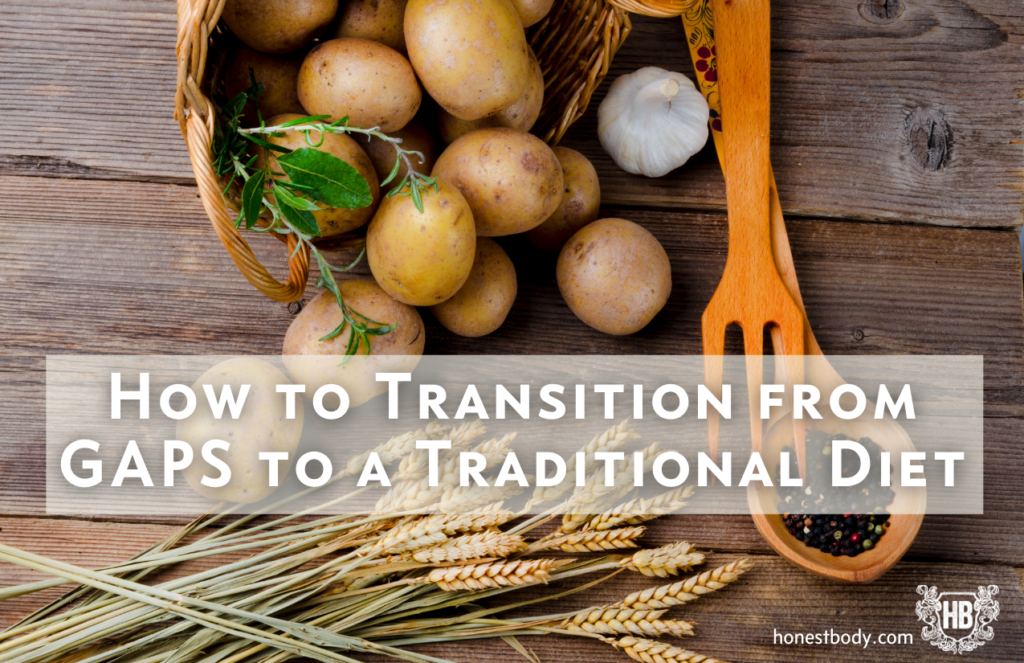Like most other successful diets and protocols, GAPS is actually a lifestyle, not just a “diet.”
Unlike most other diets and protocols, GAPS is designed to heal and seal the gut in such a powerful way that you may actually get to the point where you don’t need to be on GAPS any longer.
Though you probably won’t be able (and hopefully don’t want) to return to the Standard American Diet (aka S.A.D.) without a recurrence of problems, Dr. Natasha says in her book Gut and Physiology Syndrome that “…many GAPS people do not have to adhere to a special diet for the rest of their lives (pg 211).”
Once you have healed and your digestive system is robust once more, you will probably be able to eat most wholesome, traditional foods, at least upon occasion, without a recurrence of your symptoms. Many people are able to transition to a traditional diet such as is recommended by the Weston A. Price Foundation (WAPF).
In this post, we talk about how to transition from Full GAPS to a traditional diet that includes properly prepared starches and other foods which are excluded from GAPS.
When to Transition from Full GAPS to a Traditional Diet
The time period that one needs to be on GAPS before adding non-GAPS foods is different for everybody. Some people with milder conditions can start introducing non-GAPS foods in about a year; others need to follow GAPS really carefully for two years, and even some for the rest of their lives. See this post for all the different types of GAPS.
Basically, this is the criteria:
- Symptom-free for six months
So, unless you have a mild condition, aim for about 2 years on the GAPS diet, and at least six months without symptoms, before adding non-GAPS foods.
“A Safe Place to Camp”
- Becky Plotner states in her book GAPS, Stage by Stage, With Recipes, “Some people remain on Full GAPS for two years with no symptoms then step off GAPS during a birthday, Easter Sunday or Thanksgiving or Christmas Day, then resume with Full GAPS. If in doubt, this is a very safe place to camp (pg 415).”
- It’s important that one does not transition from Full GAPS too soon. Often people transition too quickly and experience a resurgence of symptoms, or in fact, the symptoms return worse than they were prior to doing GAPS.
- Symptoms such as joint pain, ADHD or autistic symptoms, desire for sugar-filled foods, incontinence, constipation, loose stools, trouble sleeping, headaches, bloating, or any other adverse symptoms upon introducing a non-GAPS food should not be taken lightly or pushed through (as with the introduction of therapeutic foods in the beginning). They indicate that pathogens have been fed and it is best to go back a step or two until all symptoms are cleared once more.
So, listen to your body and follow its lead. After all, your body is honest.
How to Transition from Full GAPS to a Traditional Diet
Here is the suggested order for adding non-GAPS foods.
- New potatoes: If GAPS-legal nightshades such as tomato, peppers, and eggplant are tolerated, the first new food to try is a young, new potato. New potatoes are small, fresh, and have not been in storage. Make sure the potato is organic at the least. Ideally, it should be one that you grew yourself or know the grower of since potatoes are not only heavily sprayed but also soak up pesticides very readily. Cook the potato until soft and eat it with plenty of fresh animal fat such as butter.
- Fermented gluten-free grains: The next item to introduce is gluten-free grains, such as buckwheat, quinoa, and millet. These grains must be properly fermented, as they will be much more digestible and many of the problematic carbohydrates and the phytic acid in the grains will be reduced by this process. The best resource for learning how to properly prepare grains and legumes is Monica Corrado’s book Cooking Techniques for the Gut and Psychology Syndrome™ Diet, Part IV.
- Always serve starchy foods such as grains, beans, and potatoes with plenty of good fat. This will slow down the digestion of the starch, preventing blood sugar from spiking and crashing.
- Homemade sourdough bread: Once new white potatoes and gluten-free fermented grains are tolerated, you can try some homemade sourdough bread made with an organic, preferably non-hybridized wheat (such as Einkorn) or rye flour.
- Or try Melanie’s gluten-free buckwheat pancake and waffle recipe.
How to Introduce Non-GAPS Foods
- Introduce one food at a time, in a small amount.
- Watch for any reaction for 2-3 days.
- If any symptoms return, digestive or otherwise, resume Full GAPS until symptoms clear.
- Then you may try another food (such as a different fermented gluten-free grain), or you may stay on Full GAPS for more weeks or months until you feel you are ready to try again.
- If you do not have symptoms, you can try the food again in a few days, gradually you can increase the amount per serving. Dr. Natasha says, “Do not rush the introduction of these new foods, it may take several months to do it properly (pg 210-211).”
What about Dairy?
- During your time on GAPS, you should have tried introducing ghee, butter, homemade yogurt, kefir, and sour cream, as well as the Full GAPS allowed cheeses such as naturally aged cheddar, blue cheese, or asiago. See this post for more on how to introduce dairy on GAPS.
- Once dairy items on the Full GAPS list are tolerated, try a commercial (sugar-free) probiotic yogurt, sour cream, or crème fraîche. At that point, you may also tolerate fresh cheeses, commercial or homemade, such as feta or chèvre.
- If the commercial fermented dairy is tolerated, try a raw fresh cream.
- If all goes well, you can try raw, organic milk. Find some near you here.
Still Have Questions?
To get more individualized support, including personal health history, testing, or supplement support, connect with Melanie, FNTP, CGP, RWP, and GMS Coach. Melanie holds limited spots for 1-1 GAPS Clients. For more about Melanie, see this page. Have questions? Our GAPS Services page has options to email Melanie or to schedule a free inquiry call.
Or post your question in the comments and we will try to respond as soon as we are able. You can also tell us about your experiences with transitioning from GAPS. Chime in below!


